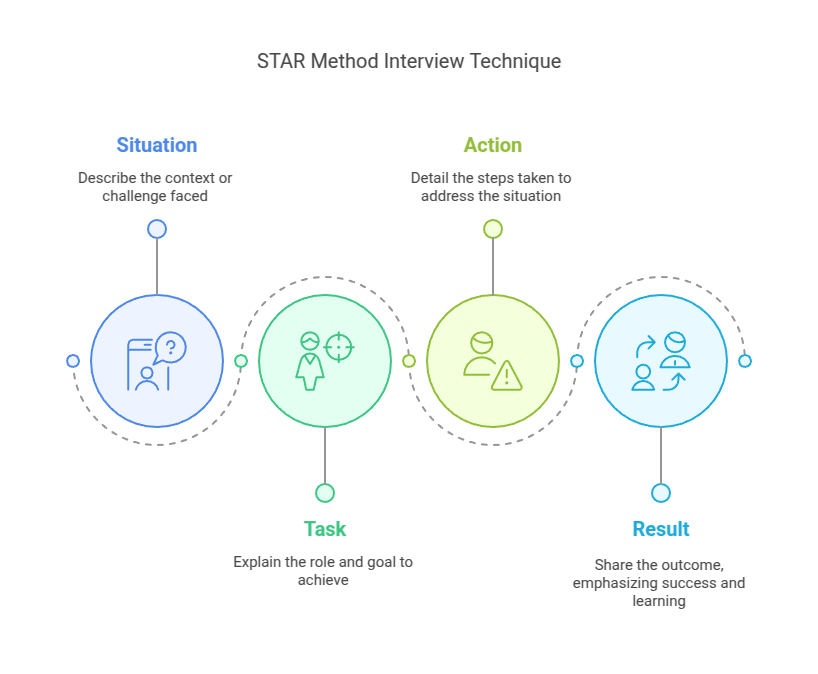Some of you after reading this post may think that this sounds like a cheating. In the opposite, it’s not about cracking an interview, but about a way to present your knowledge and experience in the most efficient way. This method is mostly useful when you face behavioral questions like “Tell me the most challenging situation from your career”.
What Is the STAR Method?
The STAR method is a technique for answering behavioral interview questions by structuring your response into four key parts:
- S – Situation: Describe the context or challenge you faced.
- T – Task: Explain your role and the goal you needed to achieve.
- A – Action: Detail the steps you took to address the situation.
- R – Result: Share the outcome of your actions, emphasizing success and learning.
This framework ensures that your answer is well-organized, relevant, and engaging for the interviewer.

How to Apply the STAR Method (with Examples)
Example 1: Handling a Difficult Client
Question: “Tell me about a time you had to handle a difficult customer.”
✅ STAR Response:
- Situation: While working as a customer support representative, I encountered a frustrated client who received a defective product and was demanding a full refund beyond the company’s policy.
- Task: My goal was to de-escalate the situation while maintaining company policy and ensuring customer satisfaction.
- Action: I actively listened to their concerns, empathized with their frustration, and offered an alternative solution—a replacement product and a discount on their next purchase.
- Result: The customer appreciated the gesture, accepted the replacement, and left positive feedback. This improved our brand’s reputation and prevented a potential loss.
Example 2: Leading a Team Through a Tight Deadline
Question: “Can you describe a time when you had to meet a tight deadline?”
✅ STAR Response:
- Situation: As a project manager, I was responsible for delivering a software update within a two-week deadline due to a product launch.
- Task: My task was to ensure that the development team completed their work on time while maintaining quality.
- Action: I organized daily stand-up meetings, prioritized tasks, and provided additional resources to accelerate development. I also communicated progress transparently to stakeholders.
- Result: The project was delivered on time, with zero critical bugs reported post-launch, leading to a successful product release and positive customer feedback.
Example 3: Resolving a Conflict in the Workplace
Question: “Tell me about a time when you had a conflict with a colleague and how you handled it.”
✅ STAR Response:
- Situation: I had a disagreement with a coworker over project priorities while working on a team assignment.
- Task: My responsibility was to ensure smooth collaboration while keeping the project on track.
- Action: I scheduled a one-on-one meeting to understand their perspective, explained my reasoning, and proposed a compromise that aligned with both our priorities.
- Result: We found a middle ground, improved our working relationship, and successfully delivered the project ahead of schedule.
Tips for Using the STAR Method Effectively
- Be concise: Avoid unnecessary details. Keep your answer to the point.
- Focus on results: Highlight measurable outcomes to show your impact.
- Tailor answers to the job: Choose relevant examples that showcase skills needed for the role.
- Practice beforehand: Prepare responses for common behavioral questions to boost confidence.
- Stay positive: Even if discussing challenges, emphasize the solution and what you learned.
Conclusion
The STAR method is a powerful way to structure your answers and make a lasting impression in job interviews. By following this framework, you’ll be able to communicate your experiences clearly and effectively, increasing your chances of landing the job.

